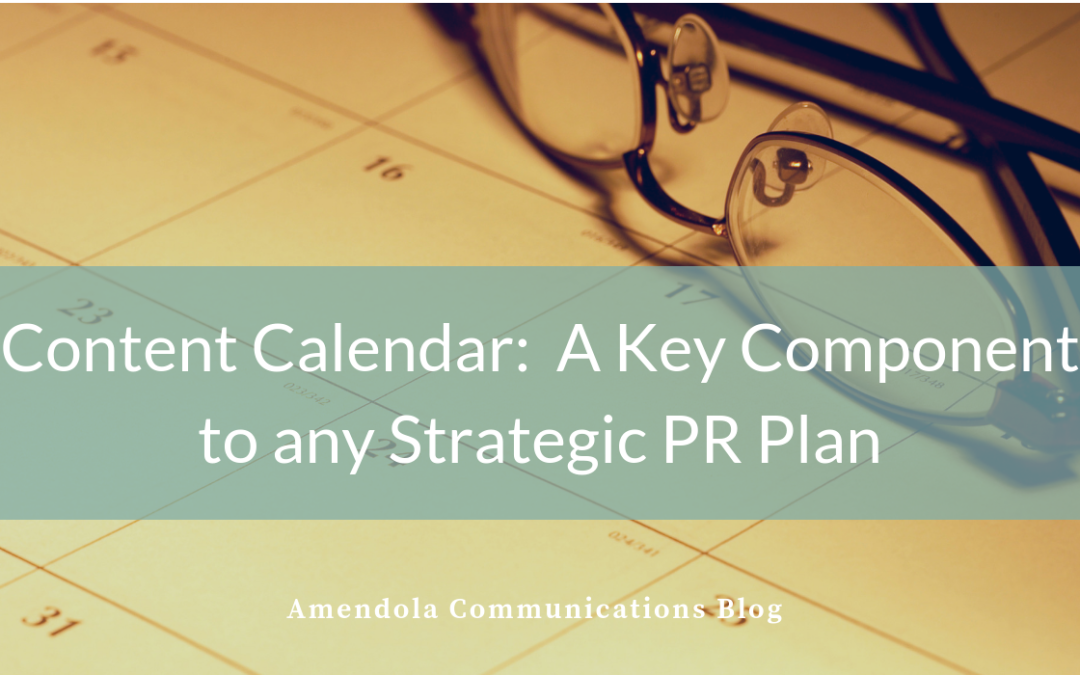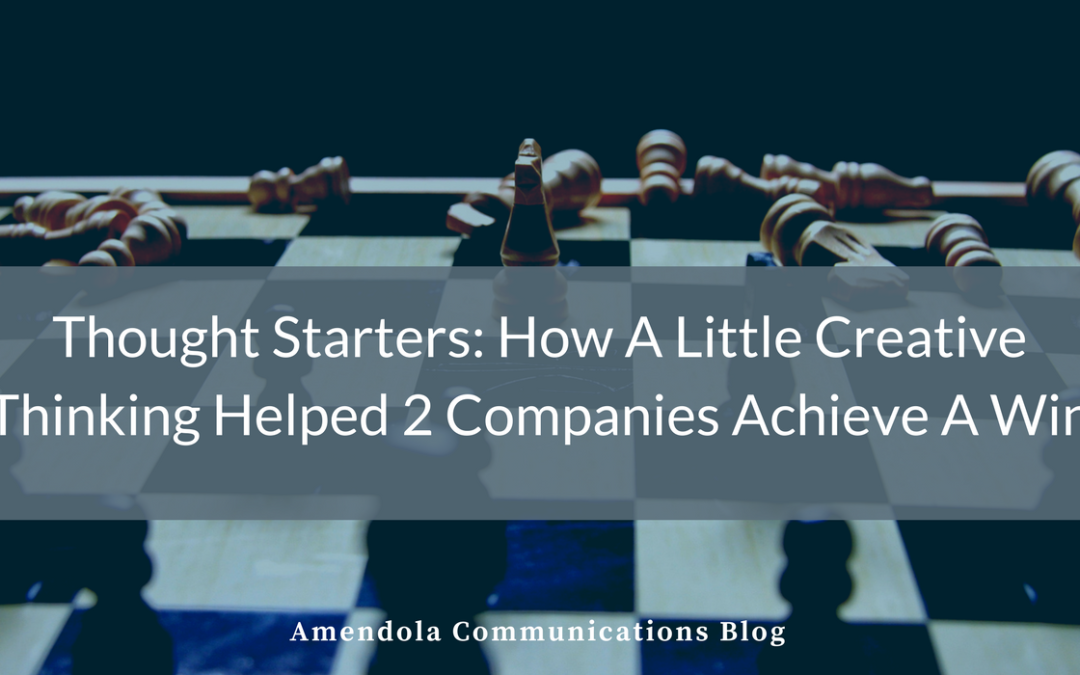
by Linda Healan | Oct 31, 2018 | Blog
Oftentimes public relations professionals think of content calendars as a tool for marketing communications programs. Having an internal editorial calendar is absolutely important for any content program. Since an integrated public relations campaign has evolved from just media relations, PR pros should also consider a content calendar as part of their overall strategic PR plan.
Knowing your audience(s) is one of the primary tenants of public relations, and the purpose of any good content is to engage, educate and encourage action. Therefore, it is necessary for us to identify those people who really are influential and approach them through high-quality content rather than corporate or product blurbs.
It is also essential to make sure that a content calendar is developed based on your overall marketing goals. What do you want to accomplish this year? What new products will be announced? Are you a start-up just entering the market or are you positioning for an IPO, other investments or hoping for an exit strategy? Positioning your executives as subject matter experts and/or thought leaders is always a good strategy in any PR Plan.
So, what should be incorporated into a public relations content calendar to reach appropriate audiences and support marketing objectives?
Events
Events are one of the best opportunities to make your public relations strategy successful, whether it is through external trade shows such as HIMSS or other health/medical conferences or internal events such as webinars and user groups. Listing upcoming events in your content calendar allows you to develop content that strategically targets potential buyers as well as current customers, and position executives and thought leaders, all based on the timeline for the events. You can tie press releases and customer case studies to events, announce executive speakers or even blog about your giveaways at a trade show.
Press Releases
A well accepted strategy in PR is to average one press release every month. This allows you to keep your name and messaging top of mind and fresh with reporters. Scheduling your press releases in advance of industry events and around product launches helps your PR team coordinate with your marketing team to make sure the news is ready to be disseminated at the right time.
Articles/Case Studies
Thought leadership articles and case studies are excellent tools in the arsenal of any PR professional to demonstrate your knowledge and experience. Planning to develop these types of articles in your content calendar and then pitching for placement in key media outlets is the kind of valuable coverage many organizations desire. Compare the articles you plan to develop to the next category editorial opportunity calendars and you’ve got a head start on content that can be published.
Editorial Opportunity Calendars
Years ago, editorial opportunity calendars were the bread and butter in any PR campaign. With the move towards online media, many publications no longer publish or adhere to editorial calendars. But some still do and researching those calendars and adding key opportunities to your PR content calendar allows you to develop content in a timely basis to pitch to those media outlets. Make sure, however, that you build in lead times into your calendar. Another benefit to editorial calendars is they give you an idea of what topics the media is interested in covering and can help you develop a list of content ideas for the year.
Other categories that can be included in an integrated PR content calendar are blogs, customer newsletters and social media outreach. There are plenty of free tools on the web that you can use to develop a content calendar.
In the end, it all works together. Having a calendar of events, press releases and editorial opportunities allows a public relations professional to strategically plan to develop content that meets deadlines, achieves marketing goals and engages, educates and encourages action from your key audiences.

by Todd Stein | Dec 13, 2017 | Blog
Introducing Hackonomics,” the campaign hinged on a report conducted by RAND (sponsored by Juniper) about the hidden economy of the hacker universe. Juniper wanted to take a fresh look at hackers to reveal the motivations and operations of the hacking community. The result was a first-of-its kind economic analysis of the cyber black market and the impact it had on targeted businesses.
Juniper built an integrated campaign that leveraged PR, marketing, government relations, sales and digital and social media. Tactics included webinars, a new website dedicated to the campaign, online ads and social media initiatives. Juniper briefed policymakers, made the report freely available in 10 languages, and distributed it across RAND’s customer base.
Here are two of the most creative elements of the campaign:
- Juniper illustrated the complexity of the hacker market by drawing the comparison to a thriving metropolis, highlighting its interconnectedness. An interactive presentation enabled viewers to see the hierarchical job functions, businesses, schools and even law enforcement roles held by active members of the cyber black market.
- An interactive timeline highlighting notable milestones and hacks over the years was shared with the cybersecurity community ahead of the report’s release to encourage conversation. Brilliantly, Juniper intentionally left key milestones off the timeline, which encouraged community members to contribute their own milestones and share the history of security hacks more broadly among their contacts.
According to Juniper, the campaign nearly doubled its share of voice over a three-month period thanks to 17,000 blog views, 1,250 executive summary downloads, and over 300 global articles, including feature placements in newswires, as well as the Financial Times, Bloomberg, The Wall Street Journal and The Daily Telegraph (UK).
Hijacking the Super Bowl
The second cool PR campaign is one of the most creative and effective uses of a limited budget that I’ve seen. In 2015, Volvo was preparing to launch a new, updated version of its XC car amid slumping sales and stiff competition from larger, more popular brands like Mercedes Benz, BMW and Lexus.
Looking for ways to tap into an affluent, millennial audience, Volvo hit on the upcoming Super Bowl, whose audience fit the mold. But the carmaker’s budget for the product launch was enough for only about one-third of one second of Super Bowl airtime.
Their solution is a textbook example of hijacking the “Volvo Interception” campaign.
While their competitors lined up to buy multi-million dollar ads for the big game, Volvo began using its social channels, other ad buys, and traditional media relations to spread the word about its campaign.
The idea was simple: Every time a competitor’s ad was broadcast during the Super Bowl, viewers using the hashtag #VolvoContest on Twitter could nominate someone to win a one of 5 new Volvo XC60s.
It worked brilliantly. The Interception campaign drove 70 percent year-over-year sales increase for the XC60. That was the highest February boost in the car’s history. The hashtag was tweeted over 55,000 times, more than any other auto-related hashtag.
The Interception campaign achieved great results by capitalizing on other brands, effectively stealing their attention and breaking through the noisiest media day of the year.
Creativity Trumps Relationships
You’ve heard it before: PR is all about relationships. It’s a tired phrase but still true. Success hinges on having a solid working relationship with key journalists, analysts and influencers.
But even more important than relationships is the ability to craft a creative pitch or campaign from a hodgepodge of information about your client their market position and history, competitive differentiators, target audience, audience influencers, budget, and a million other factors.
As the Juniper and Volvo examples show, creativity trumps relationships, and in many cases can even overcome extremely limited budgets.
The examples also illustrate the power of integrated campaigns. Combining social media, traditional media relations, marketing and advertising can exponentially magnify the impact of a good idea.
What great ideas in marketing or PR have you seen?


